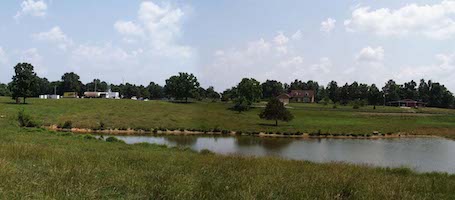Ground Sites
Dickson Site Manager: Ken Olszyna, TVA

This site is located in an area of mixed deciduous forest and pastureland approximately 53 km WNW of the center of Nashville. This site serves as an upwind/rural site. The summertime synoptic flow in this part of the country is predominately from the southwest. Therefore, this site is only rarely impacted by the Nashville urban plume. The site is occasionally impacted by the plumes from TVA's Cumberland and Johnsonville power plants located to the northwest and southwest respectively. The major emphasis of the measurements conducted at this site will be the study of rural photochemistry, with a focus on isoprene chemistry.
This site is also well instrumented for atmospheric dynamics studies. There will be two surface flux measurement experiments (one over the forest canopy, one in a nearby pasture) adjacent to this site. There will also be a moored balloon with meteorological sensors attached at various heights and a wind profiler located at this site. These measurements provide a unique opportunity to study the complex dynamics associated with rural areas with complex mixtures of landuse.
Sampling at Dickson will be through a common manifold with an inlet loacated at 10 meters.
Chemical and Meteorological measurements at the Dickson site (36º 14.82' N 87º 21.85' W)
| Parameter | Frequency | Investigator |
|---|---|---|
| O3 | 1-min., 24 hr | TVA (Olszyna) |
| NO, NO2, NOy | 1-min., 24 hr | TVA (Olszyna) |
| CO, SO2 | 1-min., 24 hr | TVA (Olszyna) |
| VOCs (canister) | 5-min, 1/day | EPA (Lonneman) |
| Oxygenated VOCs | NCAR (Apel) | |
| Isoprene and oxidation products | Purdue (Shepson) | |
| PANs, Alkyl nitrates | Western Mich. (Bertman) | |
| Aerosol mass (FRM) | 24 hr | TVA (Olszyna) |
| Aerosol speciation | 12 hr | GIT (Bauman) |
| Surface Fluxes (canopy) | NOAA/ATDD (Meyers) | |
| Surface Fluxes (pasture) | NOAA/ETL (Neff) | |
| Wind profiler | NOAA/ETL (Neff) | |
| Tethered Balloon | NOAA/ETL (Neff) | |
| wind speed, wind dir. | 1-min., 24 hr | TVA (Olszyna) |
| temp., RH, solar rad | 1-min., 24 hr | TVA (Olszyna) |
Polk Building Site Manager: Ken Olszyna, TVA

The James K. Polk building is located in the center of downtown Nashville. Sampling is performed from a 5-meter tower attached to the roof of the building. The sampling inlet is 110 meters above street level. This site recorded the highest ozone concentration (138 ppb, 1-hr) of any ground site during the 1994/1995 study. This is intended primarily as a means of documenting the urban source signature for the Nashville urban area. However, as is evidenced by the 1995 experience, significant photochemical activity can also occur in the vicinity of this site, especially under stagnation conditions.
Chemical and meteorological measurements at the Polk building site (36º 9.6' N 86º 46.8' W)
| Parameter | Frequency | Investigator |
|---|---|---|
| O3 | 1-min., 24 hr | TVA (Olszyna) |
| NO, NO2, NOy | 1-min., 24 hr | TVA (Olszyna) |
| CO, SO2 | 1-min., 24 hr | TVA (Olszyna) |
| VOCs | 5min (8/day) | ANL (Doskey) |
| CH2O | 1-min., 24 hr | EPA (McClenny), BNL (Kleinman) |
| wind speed, wind dir. | 1-min., 24 hr | TVA (Olszyna) |
| temp., RH, solar rad | 1-min., 24 hr | TVA (Olszyna) |
Cornelia Fort Air Park Site Manager: Eric Williams, NOAA AL

The Cornelia Fort Air Park is located 8-9 km to the northeast of the Polk office building site. The nearest major roads from the prevailing wind direction (SW) are 4-6 km away, which represents 1-2 hours of photochemical processing (and mixing) time. However, easterly wind will bring air from a major thoroughfare (SH 155) that is only 1 km distant. The airport is privately owned, serves mostly small private aircraft, and encompasses a large area adjacent to the Cumberland River, directly across from Opryland. The area is mostly open and flat with some small stands of forest interspersed.
This is the SOS 99 "super" chemistry site. It was selected to be at, or near, the point of maximum ozone formation rate under normal summertime advection (winds 3-10 m/s). This site hosts several major experiments.
Chemical and meteorological measurements at the Cornelia Fort site (36º 11.4' N 86º 42.0' W)
| Parameter | Frequency | Investigator |
|---|---|---|
| O3 UV abs | 1 min - 24 hr | AL (Williams) |
| O3 NO Chemi. | 1 min - 24 hr | AL (Williams) |
| NO, NOy | 1 min - 24 hr | AL (Williams) |
| CO | 1 min - 24 hr | AL (Williams) |
| SO2 | 1 min - 24 hr | AL (Williams) |
| NO2(photolytic) | 1 min - 24 hr | AL (Williams) |
| NO2(photolytic) | 1 min - 24 hr | EPA (McClenny) |
| NO2(LIF) | 1 min - 24 hr | UC Berkley (Cohen) |
| ROO (amplifer) | 1 min - 24 hr | TVA (Tanner) |
| HO, HOO | 1 min - 24 hr | PSU (Brune) |
| VOCs C2-C8 (FID-GC) | 5 min 12/day | Ohio U. (Young) |
| VOCs C2-C12 (GC-MS) | 1 hr | EPA (McClenny) |
| Aromatics, Aldehydes (CIMS) | U. Innsbruck (Hansel) | |
| CH2O (Dasgupta) | 5 min - 24 hr | EPA (McClenny) |
| CH2O (tunable diode laser) | 1 min - 24 hr | NCAR (Fried) |
| Oxygenated VOCs | NOAA/AL (Stroud) | |
| Peroxides | NOAA/AL (Jobson) | |
| PAN, PPN, MPAN | NOAA/AL (Roberts) | |
| O3/aerosol profiles | NOAA/ETL (Hardesty) | |
| PM2.5 Mass | 15 min - 24 hr | TVA (Tanner) |
| Filter speciation | 1-hr 4/day | NOAA/AL (Norton) |
| NO3, SO4, C | 5 min - 24 hr | ADI (Hering) |
| EC/OC | 15 min - 24 hr | EPA (Stockburger) |
| Particle size distribution | EPA (Stockburger) | |
| b absorption | 15 min - 24 hr | EPA (Stockburger) |
| SVOC | 12 hr daily | EPA (Stockburger) |
| Carbon isotope | 12 hr daily | EPA (Lewis) |
| MOUDI Impactor, speciation | 12 hr daily | EPA (Stockburger) |
| Wind / temp profiles | NOAA/Al (Angevine) | |
| SODAR array | NOAA/ETL (Neff) | |
| S-band radar | NOAA/ETL (Neff) | |
| Doppler winds (mini-MOPA) | NOAA/ETL (Hardesty) | |
| Water vapor profiles (mini-MOPA) | NOAA/ETL (Hardesty) | |
| Wind speed, wind direction | NOAA/ETL (Neff) | |
| RH, Solar | NOAA/ETL (Neff) | |
| Spectral Radiometer | NCAR (Shetter) | |

